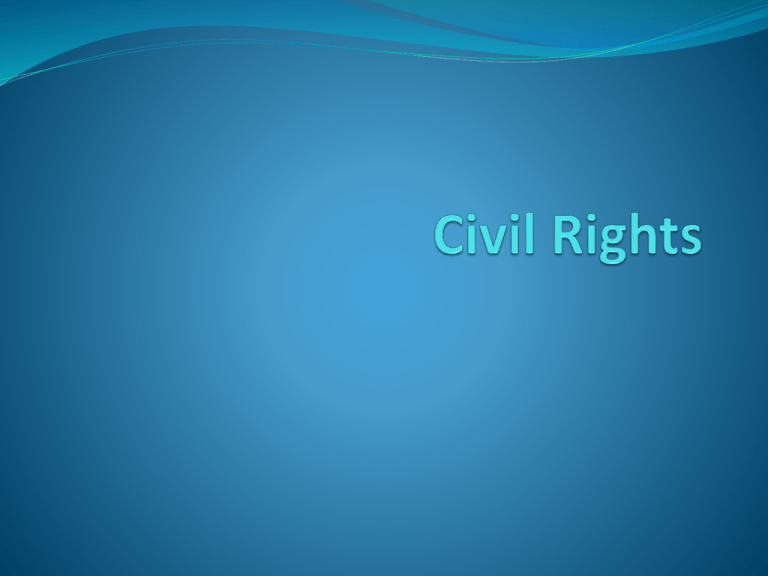
Civil Rights
Refers to government-protected rights of individuals
against arbitrary or discriminatory treatment by
governments or individuals based on categories such
as:
race,
sex,
national origin,
age,
religion
or sexual orientation
Citizenship
Missouri Compromise (1820)
Dred Scott v. Sanford (1857)
14th Amendment (1868)
Definition of a citizen
Someone born or naturalized in the U.S.
Civil War Amendments
13th-Abolishes Slavery
14th- Due process, equal protection, privileges and
immunities
15th-Right to vote regardless of race
Race
Dred Scott v. Sanford (1857)
Plessy v. Ferguson (1896)
Brown v. Board (1954)
De jure
De facto
Civil Rights Act of 1964
Leading to the legislation
Kennedy request on banning discrimination in public
accommodations
March on Washington led by King
“I Have a Dream” speech
Kennedy assassinated
Johnson, southern-born VP, put civil rights on top of his agenda as
new president.
Opposition from Strom Thurmond—longest filibuster in history of
Senate (8 weeks)
Public opinion changes (southern attitudes)
Civil Rights Act of 1964
The legislation, once passed…
Outlawed arbitrary discrimination in voter registration and
expedited voting rights lawsuits.
Barred discrimination in public accommodations engaged in
interstate commerce.
Authorized the Department of Justice to initiate lawsuits to
desegregate public facilities and schools.
Provided for the withholding of federal funds from discriminatory
state and local programs.
Prohibited discrimination in employment on grounds of race, color,
religion, and national origin, or sex.
Created the Equal Employment Opportunity Commission (EEOC)
to monitor and enforce the bans on employment discrimination.
Impact of the Civil Rights
Act of 1964
Lawsuits quickly emerged to challenge the act.
Supreme Court upheld its constitutionality.
Education
Supreme Court ruled that all state-imposed segregation (de jure
discrimination) must be eliminated at once.
De fact discrimination
Racial discrimination that results from practice rather than the law
(housing patterns, for example)
Employment
Title VII prohibits discrimination in workplace
Notion of “business necessity”
Women’s Rights
The Second Feminist Wave
Muller v. Oregon (1908)
Limited the work day for women in laundries to 10 hours
Reed v. Reed (1971)
“Arbitrary” gender discrimination violated 14th Amendment’s
Equal Protection Clause
Craig v. Boren (1976)
“Medium scrutiny” standard established for gender
discrimination
Equal Rights Amendment fails ratification by states
(1982)
Statutory Remedies for Sex
Discrimination
Title VII: prohibits discrimination by private and(after
1972) public employers
Key victories under Title VII:
Consideration of sexual harassment as sex discrimination
Inclusion of law firms, which many argued were private
partnerships, in the coverage of the act
A broad definition of what can be considered sexual
harassment, which includes same-sex harassment
Allowance of voluntary affirmative action programs to redress
historical discrimination against women
Statutory Remedies for Sex
Discrimination
Title IX
Provision of the Educational Amendments of 1972 that bars
educational institutions receiving federal funds from
discriminating against female students
Key victories under Title IX
Holding school boards or districts responsible for sexual
harassment of students by teachers
Affirmative Action
Definition: a policy designed to give special
attention to or compensatory treatment of
members of some previously disadvantaged group
In education
Regents of the University of California v. Bakke (1978)
Racial set asides unconstitutional
Race could be considered in admissions
Grutter v. Bollinger (2003)
Race could be considered a “plus” in admissions
New Civil Rights Issues
Civil Rights and the Graying of America
Age classifications not suspect category, but fall under
rational basis test.
Civil Rights and People with Disabilities
Americans with Disabilities Act of 1990
Requiring employers and public facilities to make “reasonable
accommodations” for those with disabilities
Prohibits employment discrimination against the disabled
New Civil Rights Issues
Gay and Lesbian Rights
Bowers v. Hardwick (1986)
Romer v. Evans (1996)
Lawrence v. Texas (2003)
Overturned Bowers
Private homosexual acts are protected by the Constitution
Gay marriage
Many state constitutions amended to prohibit practice
Equal Protection





